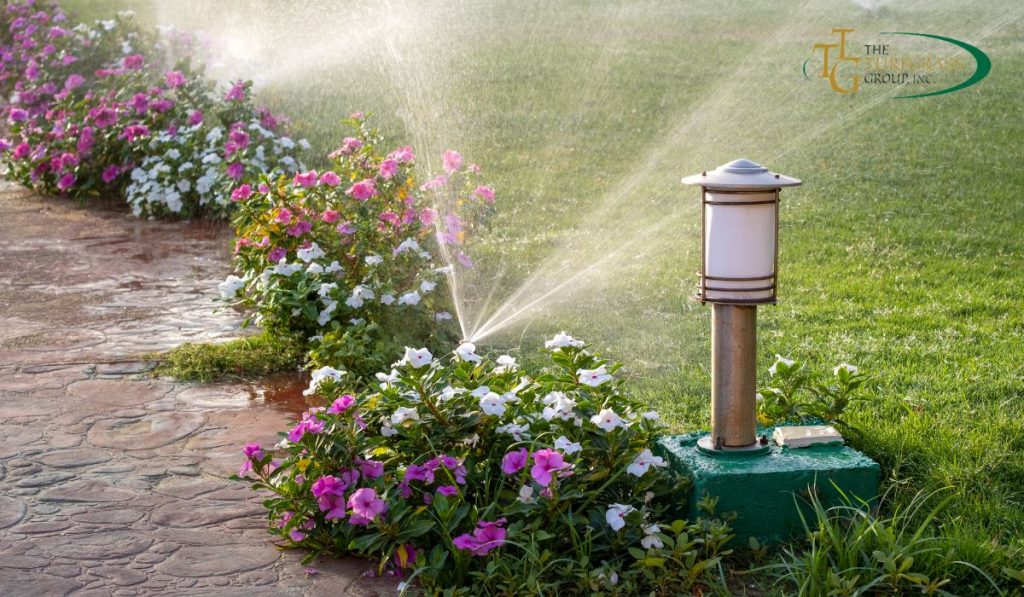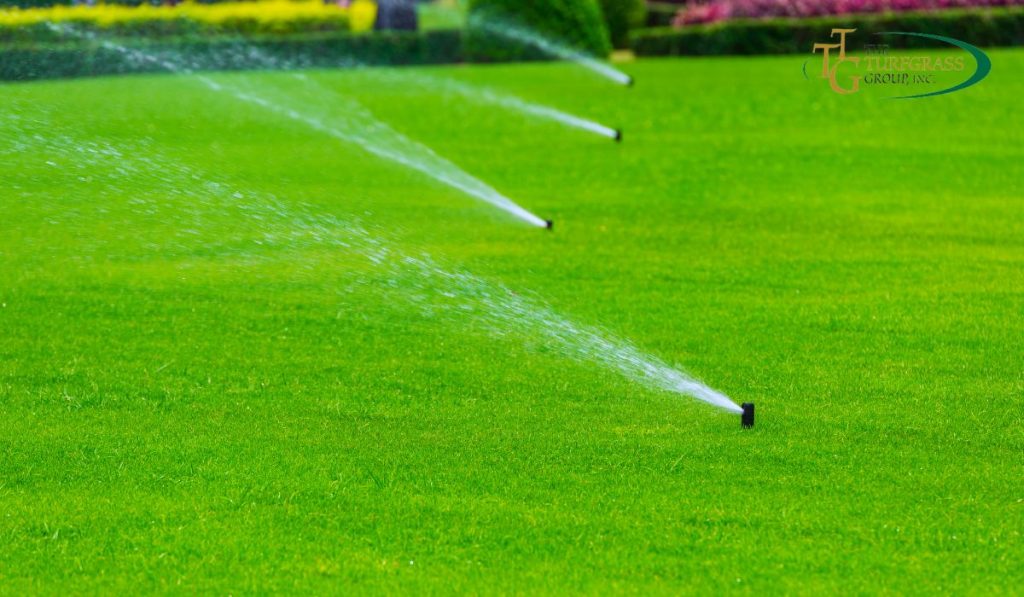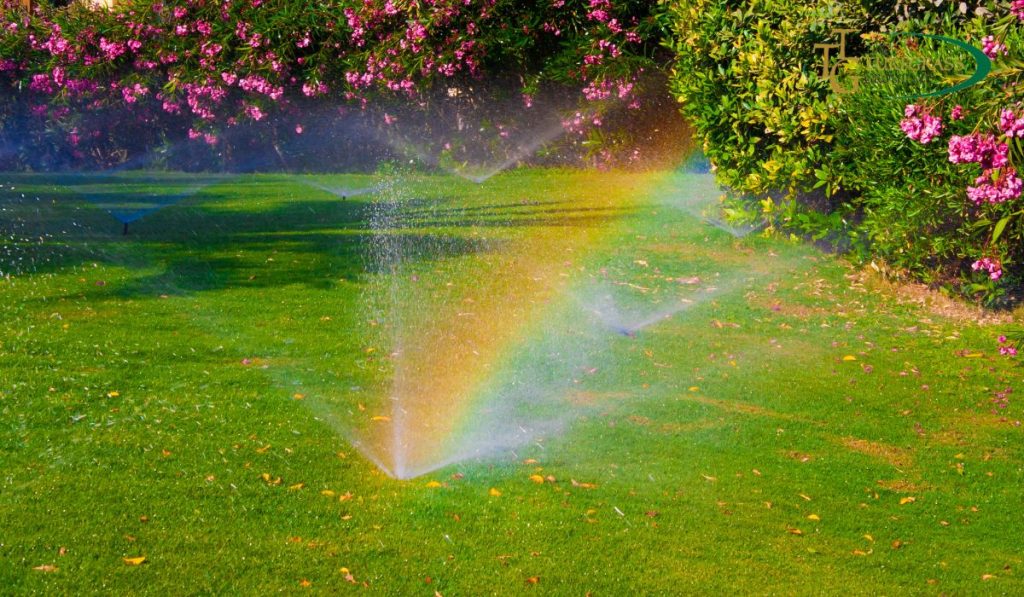
A lawn is a beautiful addition to any home.
And a lush green lawn doesn’t just look great.
It’s also functional.
Soft grass is the perfect surface for outdoor fun, from sports to barbecues to barefoot outdoor play.
Recently, water conservation concerns and general environmental awareness have led many to question the value of a grassy lawn.
Grass turf lawns comprise a considerable portion of the irrigation water in the US.
However, if you are smart about maintaining and irrigating your lawn, you can save water on your property and keep it green.
With any water conservation plan, your first step should be selecting the suitable turf for your lawn.
TifTuf™ Bermudagrass is one of the most water-efficient turfs out there.
You can save hundreds of gallons of water when you switch to TifTuf™ Bermudagrass.
Use a Rain Shut-Off Device
One of the most common ways homeowners waste water on their lawns is overwatering.
A healthy lawn only needs about 1 inch of water a week.
It doesn’t matter where that water comes from, so if it has rained in the last few days, there is no need for additional watering.
If you use an irrigation system, you can install a rain shut-off device that will automatically skip watering after a rain.
The devices cost about $200 to install, including labor.
Depending on how much you water your lawn, a rain shut-off device can pay for itself in a season or two.
Install a Smart Controller on Your Irrigation System
You can take your yard into the twenty-first century with an intelligent controller on your irrigation system.
An intelligent controller usually costs around $300 to install.
With an intelligent controller, your irrigation system can respond to data about weather, soil conditions, and plant data.
An intelligent controller is handy when you have TifTuf™ Bermudagrass.
In research studies, plots planted with TifTuf™ Bermudagrass showed a fantastic ability to hold onto water.

TifTuf™ plots consistently maintained higher soil moisture levels than those containing other bermudagrass varieties.
With an intelligent controller monitoring your soil, you can save even more water on your lawn.
Mow to The Right Height
It’s essential to know the correct mower height for your grass.
Healthy grass uses water more efficiently and requires less watering.
If you cut your grass too low, you can scalp the critical crown portion of your grass.
Scalped grass doesn’t grow deep roots, so it can’t soak up water from deep in the soil.
Also, keeping your grass at the higher end of its ideal length can help shade the soil and prevent moisture from evaporating too quickly.
TifTuf™ Bermudagrass is best mowed between ½” and 2″. While ½” may be ideal for some commercial applications, you can easily keep your home lawn at 2″.
The longer grass helps the soil retain more water and provides a softer cushion for bare feet.
Check for Leaks
Did you know a leak just 1/32″ in diameter in a hose or irrigation system can lose 6,000 gallons of water annually?
It’s easy to spot when you leak into your home.
But outdoors, a leak can be much harder to find.
Make it a habit to inspect your hoses, sprinklers, and irrigation system every time you mow to save water on your lawn.
If you have professional landscapers, ask them to check when they do their work.
Most landscapers will do it as part of their regular service.
There’s no excuse for water lost to leaks.
Water lost to leaks serves no useful purpose.
Don’t Touch Those Grass Clippings
It would help if you were mowing often enough that you aren’t taking off more than the top third of the leaf blade.
Cutting off too much can shock your grass and leave a dense layer of clippings.
But if you mow often—about once a week is recommended—you can leave those grass clippings right where they are.
Grass clippings don’t take long to break down, but as they do, they return precious nutrients to the soil.
A thin layer of clippings can also help insulate the ground so that moisture doesn’t evaporate as quickly.
Feed Your Lawn
It may seem obvious, but too many homeowners need to feed their lawns.
Or, just as bad, they overfertilize.
Using too little or too much fertilizer can harm your lawn.
Too little fertilizer won’t allow your grass to thrive and grow the firm, deep roots it needs to suck off moisture.
Too much fertilizer can feed weeds and vegetation you don’t want in your lawn.
To feed your TifTuf™ Bermudagrass lawn, use 1-2 pounds of fertilizer per 1,000 square feet.
Split that amount evenly between two feedings, one in the spring and one in the fall.
Lay Down New Turf in Spring or Fall
TifTuf™ can be installed at any time, but the best time for water efficiency is spring or fall when the weather is temperate, and water doesn’t evaporate too quickly.
Freshly installed turf needs more water than a mature lawn.
So, laying down turf in the summer means lots of water is lost to evaporation.
Use the cooler seasons to install your TifTuf™ Bermudagrass and save water on your lawn.
You’ll be happy you did it.
Install TifTuf™ Bermudagrass to Save Water on Your Lawn
There are plenty of turfgrass varieties out there.
But how many have been scientifically bred, tested, and perfected?
Researchers at the University of Georgia developed TifTuf™ Bermudagrass.
They tried thousands of genotypes, and TifTuf™ rose to the top in test after test.

Bermudagrass is known as a drought-tolerant variety, but TifTuf™ was shown to use 38% less water and retained 95% more green leaf tissue in drought stress compared to Tifway, another popular type.
TifTuf™ is licensed exclusively to The Turfgrass Group, Inc. and its sub-licensees.
It is only available through a select group of licensed, certified growers who follow stringent guidelines and undergo state certification to ensure the highest levels of quality.
TifTuf™ is top-of-the-line turf that is trusted by professionals and loved by homeowners.
You can find your closest TifTuf™ grower here, so don’t wait!
Conclusion
In conclusion, a lush green lawn is aesthetically pleasing and a functional and enjoyable space for various outdoor activities.
However, in light of growing concerns about water conservation and environmental responsibility, adopting innovative practices to maintain your lawn while minimizing water usage is crucial.
TifTuf™ Bermudagrass emerges as a remarkable choice due to its exceptional water efficiency.
By following the recommended steps, such as using rain shut-off devices, installing intelligent controllers, mowing at the right height, checking for leaks, leaving grass clippings, and feeding your lawn appropriately, you can significantly reduce water wastage and ensure the health and vibrancy of your property.
Additionally, timing the installation of TifTuf™ Bermudagrass during temperate seasons can save water and promote a thriving, water-efficient lawn.
TifTuf™ Bermudagrass is the product of extensive research and development, boasting a 38% reduction in water usage and a 95% increase in green leaf tissue retention during drought stress compared to other popular varieties.
This drought-tolerant grass offers a sustainable solution for homeowners who wish to conserve water without sacrificing the beauty and functionality of their lawns.
To take advantage of these benefits, purchase TifTuf™ from a certified grower who adheres to strict quality standards.
FAQs:
Why is water conservation important for lawns?
Water conservation is essential for lawns because it helps to minimize water wastage and environmental impact. Lawns are a significant source of water usage, and conserving water reduces utility bills and contributes to sustainability and responsible environmental practices.
What is TifTuf™ Bermudagrass, and why is it recommended for water-efficient lawns?
TifTuf™ Bermudagrass is a scientifically bred and tested variety known for its exceptional water efficiency. It uses 38% less water and retains 95% more green leaf tissue during drought stress than other varieties. It’s an excellent choice for homeowners who maintain a lush lawn while conserving water.
How can I prevent overwatering my lawn?
Overwatering can be prevented by using a rain shut-off device to skip watering after rain and installing an intelligent controller that responds to weather and soil conditions. These technologies help ensure your lawn receives only the necessary amount of water.
What is the right height for mowing my lawn, and why is it important?
The correct mowing height depends on your grass type, but keeping your grass at a higher altitude can help shade the soil, prevent moisture from evaporating quickly, and promote healthier root growth. For TifTuf™ Bermudagrass, a height of ½” to 2″ is recommended.
How can I identify and fix leaks in my irrigation system?
Regularly inspect your hoses, sprinklers, and irrigation system for leaks. If you have professional landscapers, request them to check for leaks during their regular service. Fixing even small leaks can save thousands of gallons of water each year.
Why should I leave grass clippings on my lawn after mowing?
Leaving grass clippings on your lawn is beneficial as they decompose quickly, returning essential nutrients to the soil. Clippings also help insulate the soil, reducing moisture evaporation and promoting overall lawn health.
When is the best time to lay down the new TifTuf™ Bermudagrass for water efficiency?
The ideal times to lay down new TifTuf™ Bermudagrass are in the spring or fall when weather conditions are temperate and water evaporation is minimized. This ensures that your newly installed turf receives the appropriate amount of water.
Where can I purchase TifTuf™ Bermudagrass for my lawn?
TifTuf™ Bermudagrass is exclusively licensed to The Turfgrass Group, Inc. and its sub-licensees. You can find your closest TifTuf™ grower by visiting their website and ensuring you receive top-quality, water-efficient turf for your lawn.